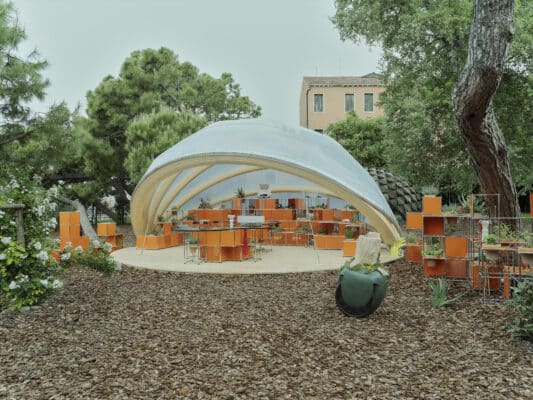The unEarthed / Second Nature / PolliNATION project explores how sustainable bio-based materials can reshape architecture to support both humans and pollinators. This effort, presented at the 2025 Venice Biennale, highlights the urgent need for sustainable design that benefits ecosystems worldwide.
Project Location and Key Contributors
Held in Venice, Italy, this initiative prominently features architect Enric Ruiz Geli and academic Anne-Lise Velez. Additionally, Barcelona’s Cloud 9 studio and researchers from Virginia Tech contribute by blending digital design with eco-friendly, sustainable bio-based materials.


Cloud 9 Designs: Climate-Responsive Structures Using Biodegradable Building Materials
Cloud 9 creates adaptable structures that respond to climate challenges by using sustainable bio-based materials. These designs feature:
- Modular forms
- Passive cooling and ventilation
- Coastal erosion resistance
- Circular design principles
Such choices reduce environmental impact while promoting biodiversity.
Academic Research Addressing Material and Social Challenges
At Virginia Tech, several projects use sustainable bio-based materials combined with technology to solve real-world issues:
| Project | Field | Objective | Technical Details |
|---|---|---|---|
| Smart Silvopasture Management | Sustainable Agriculture | Enhance biodiversity with robotics | Forest monitoring systems |
| Capsule-Based Sleep System | Space Environment | Improve well-being and efficiency | Thermal regulation, compact design |
| Inclusive Aircraft Seating | Transportation | Accommodate wheelchair users | Adjustable, commercial solutions |
| Educational Infrastructure | Social Inclusion | Create learning spaces for inmates | Durable, recyclable materials |


Analysis: Regenerative Design with Biodegradable Materials
Using sustainable bio-based materials allows architects to move beyond mere sustainability and toward true regeneration. Specifically, these materials:
- Break down naturally, reducing environmental impact;
- Support pollinators and wildlife, enhancing biodiversity;
- Enable efficient digital fabrication, streamlining construction processes.
Consequently, this approach treats materials as active partners in ecosystem recovery rather than passive elements.
Comparative Table of Biodegradable vs Traditional Materials
| Feature | Biodegradable Materials | Traditional Materials (Concrete, Glass) |
|---|---|---|
| Environmental Impact | Low, renewable, decomposable | High emissions, non-degradable |
| Thermal Performance | Natural insulation | Requires added insulation |
| Design Flexibility | High, digitally fabricated | Limited adaptability |
| Biodiversity Support | Supports ecosystems | No direct support |
| Cost | Variable | Stable, established |
Conclusion
Ultimately, the unEarthed / Second Nature / PolliNATION project clearly demonstrates how sustainable bio-based materials can effectively create architecture that restores ecosystems. Moreover, this visionary approach significantly guides future designs toward true ecological regeneration.
ArchUp is your platform to follow everything “architectural“: news, analyses, and designs straight from the heart of the modern architectural movement.







